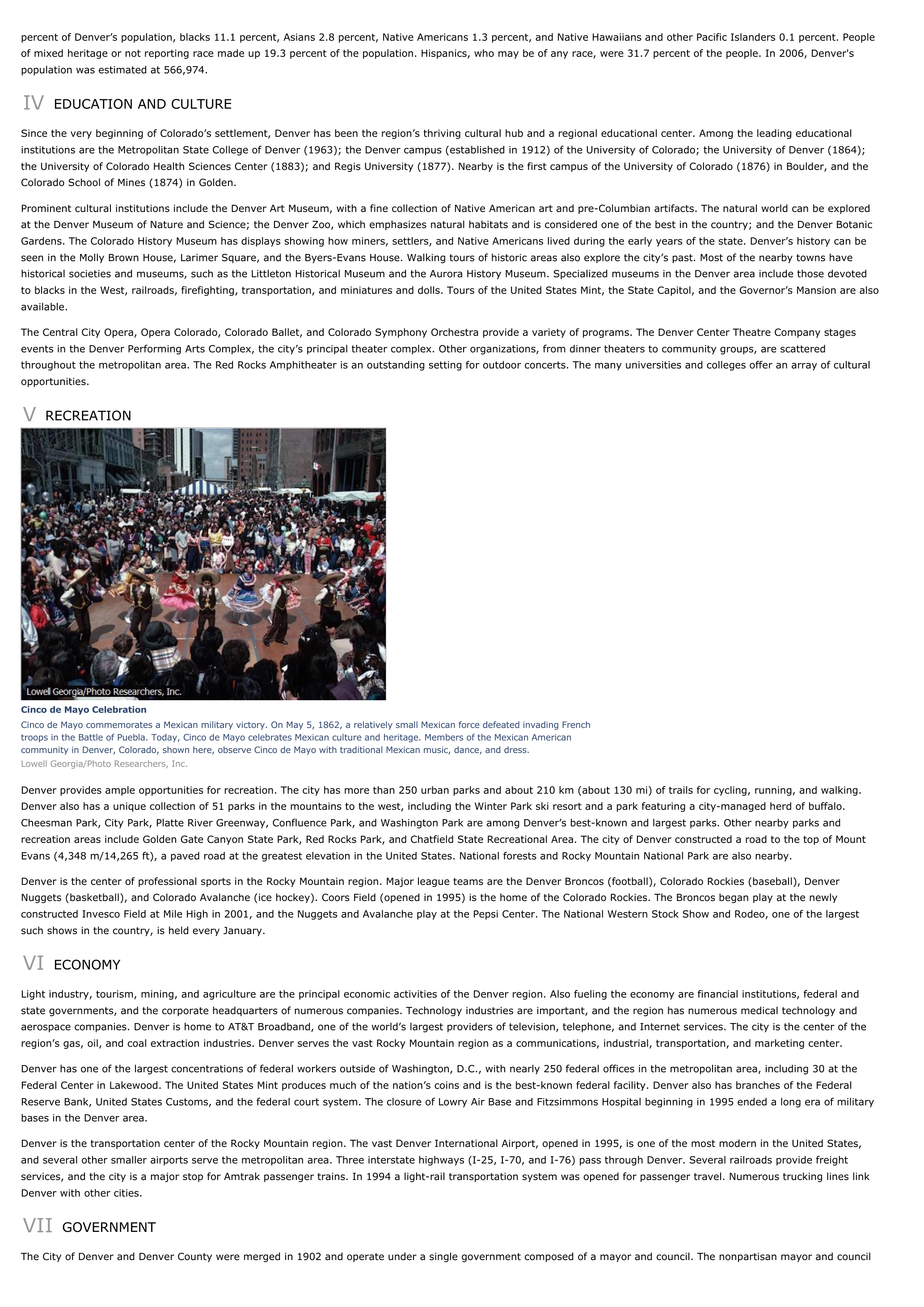Denver - geography.
Publié le 27/05/2013

Extrait du document
«
percent of Denver’s population, blacks 11.1 percent, Asians 2.8 percent, Native Americans 1.3 percent, and Native Hawaiians and other Pacific Islanders 0.1 percent.
Peopleof mixed heritage or not reporting race made up 19.3 percent of the population.
Hispanics, who may be of any race, were 31.7 percent of the people.
In 2006, Denver'spopulation was estimated at 566,974.
IV EDUCATION AND CULTURE
Since the very beginning of Colorado’s settlement, Denver has been the region’s thriving cultural hub and a regional educational center.
Among the leading educationalinstitutions are the Metropolitan State College of Denver (1963); the Denver campus (established in 1912) of the University of Colorado; the University of Denver (1864);the University of Colorado Health Sciences Center (1883); and Regis University (1877).
Nearby is the first campus of the University of Colorado (1876) in Boulder, and theColorado School of Mines (1874) in Golden.
Prominent cultural institutions include the Denver Art Museum, with a fine collection of Native American art and pre-Columbian artifacts.
The natural world can be exploredat the Denver Museum of Nature and Science; the Denver Zoo, which emphasizes natural habitats and is considered one of the best in the country; and the Denver BotanicGardens.
The Colorado History Museum has displays showing how miners, settlers, and Native Americans lived during the early years of the state.
Denver’s history can beseen in the Molly Brown House, Larimer Square, and the Byers-Evans House.
Walking tours of historic areas also explore the city’s past.
Most of the nearby towns havehistorical societies and museums, such as the Littleton Historical Museum and the Aurora History Museum.
Specialized museums in the Denver area include those devotedto blacks in the West, railroads, firefighting, transportation, and miniatures and dolls.
Tours of the United States Mint, the State Capitol, and the Governor’s Mansion are alsoavailable.
The Central City Opera, Opera Colorado, Colorado Ballet, and Colorado Symphony Orchestra provide a variety of programs.
The Denver Center Theatre Company stagesevents in the Denver Performing Arts Complex, the city’s principal theater complex.
Other organizations, from dinner theaters to community groups, are scatteredthroughout the metropolitan area.
The Red Rocks Amphitheater is an outstanding setting for outdoor concerts.
The many universities and colleges offer an array of culturalopportunities.
V RECREATION
Cinco de Mayo CelebrationCinco de Mayo commemorates a Mexican military victory.
On May 5, 1862, a relatively small Mexican force defeated invading Frenchtroops in the Battle of Puebla.
Today, Cinco de Mayo celebrates Mexican culture and heritage.
Members of the Mexican Americancommunity in Denver, Colorado, shown here, observe Cinco de Mayo with traditional Mexican music, dance, and dress.Lowell Georgia/Photo Researchers, Inc.
Denver provides ample opportunities for recreation.
The city has more than 250 urban parks and about 210 km (about 130 mi) of trails for cycling, running, and walking.Denver also has a unique collection of 51 parks in the mountains to the west, including the Winter Park ski resort and a park featuring a city-managed herd of buffalo.Cheesman Park, City Park, Platte River Greenway, Confluence Park, and Washington Park are among Denver’s best-known and largest parks.
Other nearby parks andrecreation areas include Golden Gate Canyon State Park, Red Rocks Park, and Chatfield State Recreational Area.
The city of Denver constructed a road to the top of MountEvans (4,348 m/14,265 ft), a paved road at the greatest elevation in the United States.
National forests and Rocky Mountain National Park are also nearby.
Denver is the center of professional sports in the Rocky Mountain region.
Major league teams are the Denver Broncos (football), Colorado Rockies (baseball), DenverNuggets (basketball), and Colorado Avalanche (ice hockey).
Coors Field (opened in 1995) is the home of the Colorado Rockies.
The Broncos began play at the newlyconstructed Invesco Field at Mile High in 2001, and the Nuggets and Avalanche play at the Pepsi Center.
The National Western Stock Show and Rodeo, one of the largestsuch shows in the country, is held every January.
VI ECONOMY
Light industry, tourism, mining, and agriculture are the principal economic activities of the Denver region.
Also fueling the economy are financial institutions, federal andstate governments, and the corporate headquarters of numerous companies.
Technology industries are important, and the region has numerous medical technology andaerospace companies.
Denver is home to AT&T Broadband, one of the world’s largest providers of television, telephone, and Internet services.
The city is the center of theregion’s gas, oil, and coal extraction industries.
Denver serves the vast Rocky Mountain region as a communications, industrial, transportation, and marketing center.
Denver has one of the largest concentrations of federal workers outside of Washington, D.C., with nearly 250 federal offices in the metropolitan area, including 30 at theFederal Center in Lakewood.
The United States Mint produces much of the nation’s coins and is the best-known federal facility.
Denver also has branches of the FederalReserve Bank, United States Customs, and the federal court system.
The closure of Lowry Air Base and Fitzsimmons Hospital beginning in 1995 ended a long era of militarybases in the Denver area.
Denver is the transportation center of the Rocky Mountain region.
The vast Denver International Airport, opened in 1995, is one of the most modern in the United States,and several other smaller airports serve the metropolitan area.
Three interstate highways (I-25, I-70, and I-76) pass through Denver.
Several railroads provide freightservices, and the city is a major stop for Amtrak passenger trains.
In 1994 a light-rail transportation system was opened for passenger travel.
Numerous trucking lines linkDenver with other cities.
VII GOVERNMENT
The City of Denver and Denver County were merged in 1902 and operate under a single government composed of a mayor and council.
The nonpartisan mayor and council.
»
↓↓↓ APERÇU DU DOCUMENT ↓↓↓

































